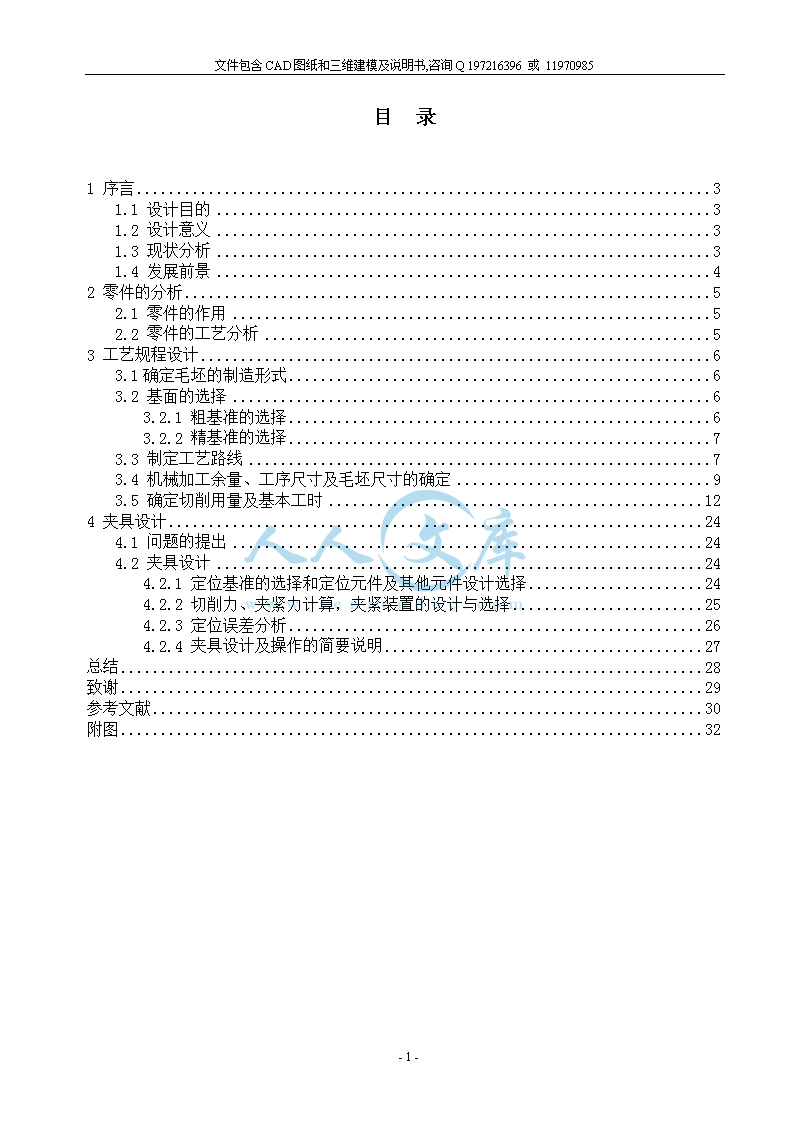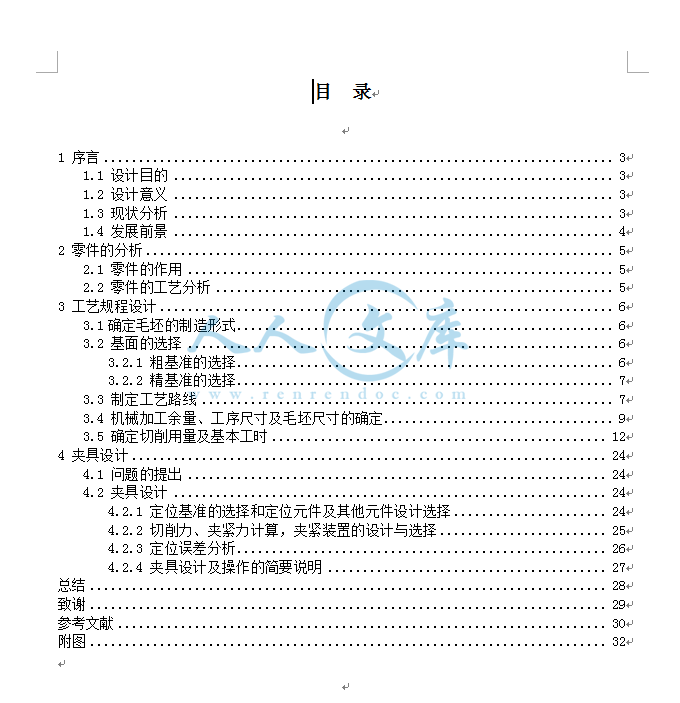CA6140车床手柄座加工工艺规程及夹具设计【含工艺卡、工序卡、说明书及三维PROE和CAD图纸】
收藏
资源目录

压缩包内文档预览:
编号:10625896
类型:共享资源
大小:8.36MB
格式:ZIP
上传时间:2018-09-03
上传人:机****料
认证信息
个人认证
高**(实名认证)
河南
IP属地:河南
50
积分
- 关 键 词:
-
ca6140
车床
手柄
加工
工艺
规程
夹具
设计
工序
说明书
仿单
三维
proe
以及
cad
图纸
- 资源描述:
-















- 内容简介:
-
- # PAGE #6# -ter wear, especially at high cutting speeds. Stainless steels. Austenitic (300 series) steels are generally difficult to machine. Chatter can be s problem, necessitating machine tools with high stiffness. However, ferrite stainless steels (also 300 series) have good machinability. Martensitic (400 series) steels are abrasive, tend to form a built-up edge, and require tool materials with high hot hardness and crater-wear resistance. Precipitation-hardening stainless steels are strong and abrasive, requiring hard and abrasion-resistant tool materials. The effects of other elements in steels on machinability. The presence of aluminum and silicon in steels is always harmful because these elements combine with oxygen to form aluminum oxide and silicates,which are hard and abrasive. These compounds increase tool wear and reduce machinability. It is essential to produce and use clean steels. Carbon and manganese have various effects on the machinability of steels, depending on their composition. Plain low-carbon steels (less than 0.15% C) can produce poor surface finish by forming a built-up edge. Cast steels are more abrasive, although their machinability is similar to that of wrought steels. Tool and die steels are very difficult to machine and usually require annealing prior to machining. Machinability of most steels is improved by cold working, which hardens the material and reduces the tendency for built-up edge formation. Otheralloying elements, such as nickel, chromium, molybdenum, and vanadium, which improve the properties of steels, generally reduce machinability. The effect of boron is negligible. Gaseous elements such as hydrogen and nitrogen can have particularly detrimental effects on the properties of steel. Oxygen has been shown to have a strong effect on the aspect ratio of the manganese sulfide inclusions; the higher the oxygen content, the lower the aspect ratio and the higher the machinability. In selecting various elements to improve machinability, we should consider the possible detrimental effects of these elements on the properties and strength of the machined part in service. At elevated temperatures, for example, lead causes embitterment of steels (liquid-metal embitterment, hot shortness; see Section 1.4.3), although at room temperature it has no effect on mechanical properties. Sulfur can severely reduce the hot workability of steels, because of the formation of iron sulfide, unless sufficient manganese is present to prevent such formation. At room temperature, the mechanical properties of resulfurized steels depend on the orientation of the deformed manganese sulfide inclusions (anisotropy). Rephosphorized steels are significantly less ductile, and are produced solely toimprove machinability. o machine than brass. Magnesium is very easy to machine, with good surface finish and prolonged tool life. However care should be exercised because of its high rate of oxidation and the danger of fire (the element is hydrophobic). Molybdenum is ductile and work-hardening, so it can produce poor surface finish. Sharp tools are necessary. Nickel-based alloys are work-hardening, abrasive, and strong at high temperatures. Their machinability is similar to that of stainless steels. Tantalum is very work-hardening, ductile, and soft. It produces a poor surface finish; tool wear is high. Titanium and its alloys have poor thermal conductivity (indeed, the lowest of all metals), causing significant temperature rise and built-up edge; they can bedifficult to machine. Tungsten is brittle, strong, and very abrasive, so its machinability is low, although it greatly improves at elevated temperatures. Zirconium has good machinability. It requires a coolant-type cutting fluid, however, because of the explosion and fire. To relieve these stresses, machined parts can be annealed for a period of time at temperatures ranging from C80 to C160 (F175 to F315), and then cooled slowly and uniformly to room temperature. Thermosetting plastics are brittle andsensitive to thermal gradients during cutting. Their machinability is generally similar to that of thermoplastics. Because of the fibers present, reinforced plastics are very abrasive and are difficult to machine. Fiber tearing, pulling,and edge delaminating are significant problems; they can lead to severe reduction in the load-carrying capacity of the component. Furthermore, machiningof these materials requires careful removal of machining debris to avoid contactwith and inhaling of the fibers. The machinability of ceramics has improved steadily with the development of nanoceramics (Section 8.2.5) and with the selection of appropriate processing parameters, such as ductile-regime cutting (Section 22.4.2). Metal-matrix and ceramic-matrix composites can be difficult tomachine, depending on the properties of the individual components, i.e., reinforcing or whiskers, as well as the matrix material. 因素的方式定义:1、分的表面光洁性和表面完整性。2、刀具的寿命。3、切削力和功率的需求。4、切屑控制。以这种方式,好的可机加工性指的是好的表面光洁性和完整性,长的刀具寿命,低的切削力和功率需求。关于切屑控制,细长的卷曲切屑,如果没有被切割成小片,以在切屑区变的混乱,缠在一起的方式能够严重的介入剪切工序。因为剪切工序的复杂属性,所以很难建立定量地释义材料的可机加工性的关系。在制造厂里,刀具寿命和表面粗糙度通常被认为是可机加工性中最重要的因素。尽管已不再大量的被使用,近乎准确的机加工率在以下的例子中能够被看到。,但也有磨蚀性。铸造无中的 低 的可机加工性, 起刀具切屑 。 需要具有 性的工具。具有 的刀具材料的 铸 和 性 是可加工的。 有磨蚀性 度加工 的。 要求的 具有 蚀性的刀具材料 有低的 刀和 度。尽管铸 很 机加工,但因为 的屑成因 很难机加工。 很 机加工,cu
- 温馨提示:
1: 本站所有资源如无特殊说明,都需要本地电脑安装OFFICE2007和PDF阅读器。图纸软件为CAD,CAXA,PROE,UG,SolidWorks等.压缩文件请下载最新的WinRAR软件解压。
2: 本站的文档不包含任何第三方提供的附件图纸等,如果需要附件,请联系上传者。文件的所有权益归上传用户所有。
3.本站RAR压缩包中若带图纸,网页内容里面会有图纸预览,若没有图纸预览就没有图纸。
4. 未经权益所有人同意不得将文件中的内容挪作商业或盈利用途。
5. 人人文库网仅提供信息存储空间,仅对用户上传内容的表现方式做保护处理,对用户上传分享的文档内容本身不做任何修改或编辑,并不能对任何下载内容负责。
6. 下载文件中如有侵权或不适当内容,请与我们联系,我们立即纠正。
7. 本站不保证下载资源的准确性、安全性和完整性, 同时也不承担用户因使用这些下载资源对自己和他人造成任何形式的伤害或损失。

人人文库网所有资源均是用户自行上传分享,仅供网友学习交流,未经上传用户书面授权,请勿作他用。
 川公网安备: 51019002004831号
川公网安备: 51019002004831号